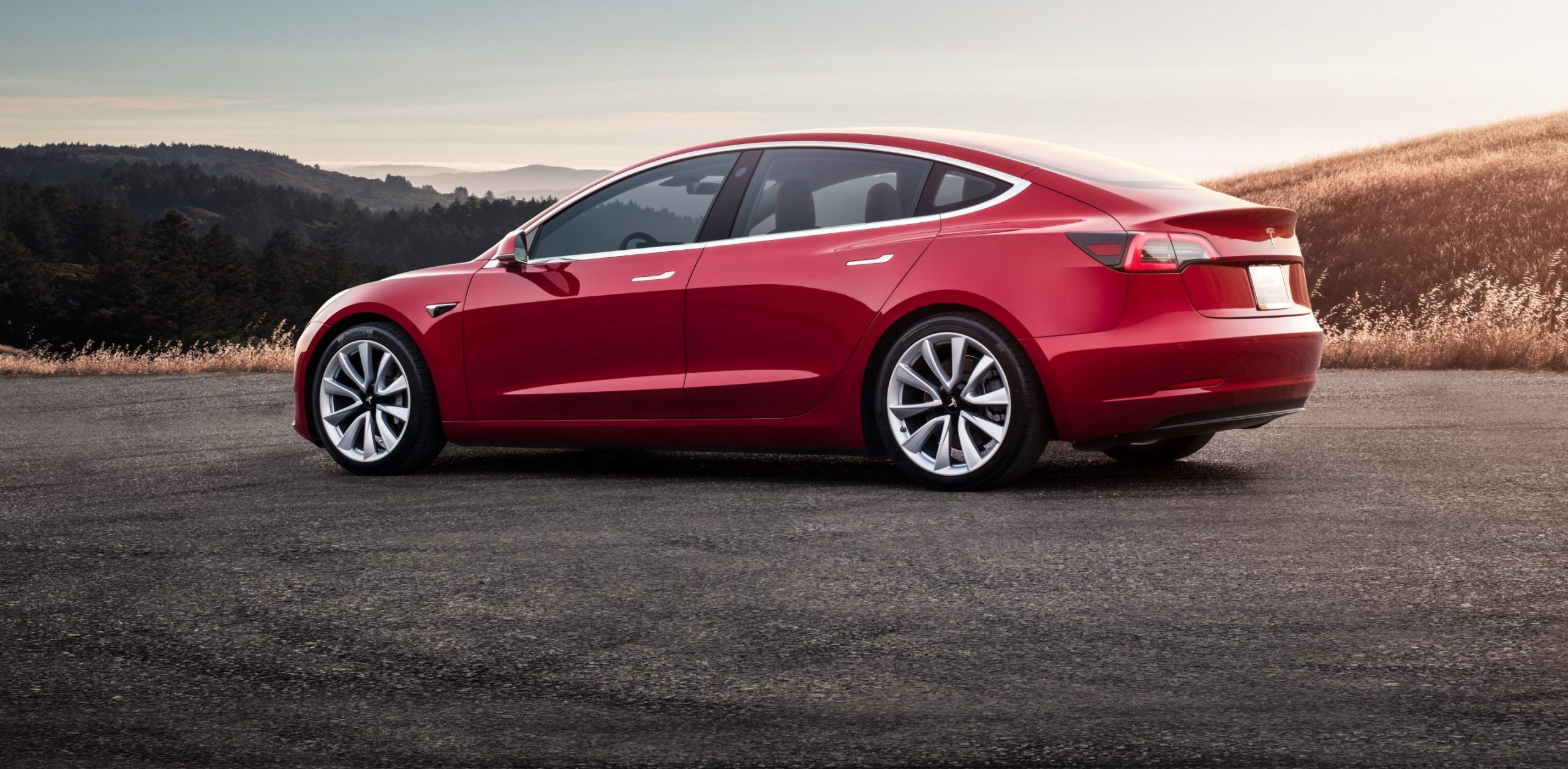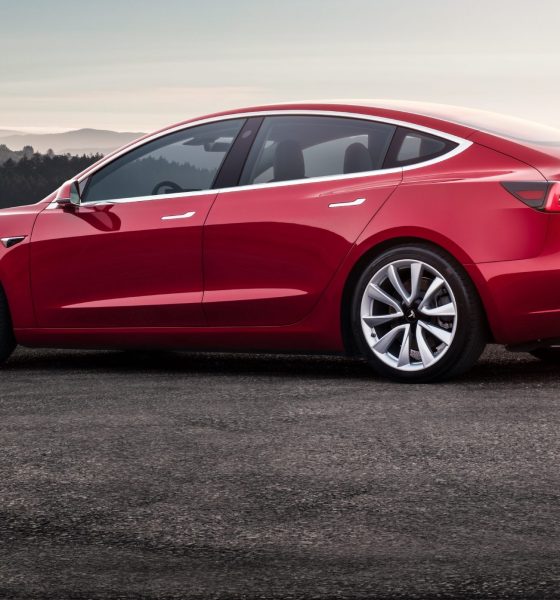

News
Tesla Model 3 dubbed best electric car by noted auto reviewer in 3-way evaluation
Noted auto reviewer Matthew DeBord has a lot of experience driving Tesla’s electric cars, lauding the Model 3 Performance as his personal favorite among the company’s vehicles in a review last month. His conclusions were appreciated by Elon Musk, who shared the veteran reviewer’s article on Twitter. Recently, DeBord raised the stakes for the Model 3, comparing it against two other premium electric cars he has driven in the past — the Jaguar I-PACE and Tesla’s own Model X — to see which EV is the best in the market today.
For purposes of his recent review, DeBord opted to use the Model 3’s Long Range RWD version, which cost $57,500 when it was acquired last year. The electric sedan was compared against the Jaguar I-PACE EV400 HSE, which costs a total of $86,720 with options and fees. The final vehicle in the triple threat evaluation — a fully-loaded Tesla Model X P100D — came at a premium price of $150,000.
In his analysis, DeBord noted that the Jaguar I-PACE is poised, powerful, and sleek, and it has a killer interior accented with premium materials such as brushed metal, carbon fiber, and wood. That said, the Jaguar does fall short in some areas such as its frunk, which is too small for any practical use. Its charging system, which relies on ChargePoint’s stations, also left much to be desired. Jaguar Land Rover’s InControl Touch Pr infotainment system is “too complex” and “not attractively designed” as well.
On the other hand, DeBord admits that the Tesla Model X P100D is a showstopper with its tech and features like its Falcon Wing Doors. Being the largest of the three vehicles, the Model X is a champion of storage with almost 90 cubic feet of available cargo space. Coupled with the Supercharger Network and its Ludicrous Mode, the Model X is an excellent vehicle. That said, the premium SUV also carries a very premium price.
Ultimately, DeBord opted to give the crown to the Tesla Model 3 as the best electric car among the three vehicles he evaluated. The Model 3 strikes a great balance for price and features, with its 0-60 mph time of 5.1 seconds and its access to the Supercharger Network. The auto reviewer also lauds the vehicle for its intuitive touchscreen and steering wheel trackball-based controls, which “provides a serene driving experience” after a small learning curve. Reiterating his observations in his initial review of the electric sedan, DeBord noted that there is simply nothing better among electric cars available in the market today, especially considering its price.
“There is no better vehicle of this type at this price that I believe I could currently buy. What’s really so hypnotically and addictively compelling about the Model 3 is how many great ideas have been crammed into one automobile. This is a car that’s absolutely bursting with thought, about the present and the future — and the distant future. Those ideas are overwhelmingly optimistic.”
What’s impressive is that the Tesla Model 3 which DeBord based his recent conclusion from is a rather early version of the electric sedan. Since the initial production of the electric car, Tesla has achieved a notable reduction on Model 3 costs, as evidenced by the $49,900 starting price of the Dual Motor AWD Model 3 today. Other improvements have also been rolled out by Tesla since DeBord’s initial review of the vehicle, such as Navigate on Autopilot.
Matthew DeBord is not alone in his conclusions with regards to the Model 3. Auto veteran and longtime gearhead Henry Payne of The Detroit News, for one, even dubbed the Tesla Model 3 as the publication’s 2018 Car of the Year. The vehicle has also been a commercial success for Tesla, selling more than 145,000 units over 2018, allowing it to become the year’s best-selling luxury car.

Elon Musk
Elon Musk confirms xAI’s purchase of five 380 MW natural gas turbines
The deal, which was confirmed by Musk on X, highlights xAI’s effort to aggressively scale its operations.

xAI, Elon Musk’s artificial intelligence startup, has purchased five additional 380 MW natural gas turbines from South Korea’s Doosan Enerbility to power its growing supercomputer clusters.
The deal, which was confirmed by Musk on X, highlights xAI’s effort to aggressively scale its operations.
xAI’s turbine deal details
News of xAI’s new turbines was shared on social media platform X, with user @SemiAnalysis_ stating that the turbines were produced by South Korea’s Doosan Enerbility. As noted in an Asian Business Daily report, Doosan Enerbility announced last October that it signed a contract to supply two 380 MW gas turbines for a major U.S. tech company. Doosan later noted in December that it secured an order for three more 380 MW gas turbines.
As per the X user, the gas turbines would power an additional 600,000+ GB200 NVL72 equivalent size cluster. This should make xAI’s facilities among the largest in the world. In a reply, Elon Musk confirmed that xAI did purchase the turbines. “True,” Musk wrote in a post on X.
xAI’s ambitions
Recent reports have indicated that xAI closed an upsized $20 billion Series E funding round, exceeding the initial $15 billion target to fuel rapid infrastructure scaling and AI product development. The funding, as per the AI startup, “will accelerate our world-leading infrastructure buildout, enable the rapid development and deployment of transformative AI products.”
The company also teased the rollout of its upcoming frontier AI model. “Looking ahead, Grok 5 is currently in training, and we are focused on launching innovative new consumer and enterprise products that harness the power of Grok, Colossus, and 𝕏 to transform how we live, work, and play,” xAI wrote in a post on its website.
Elon Musk
Elon Musk’s xAI closes upsized $20B Series E funding round
xAI announced the investment round in a post on its official website.

xAI has closed an upsized $20 billion Series E funding round, exceeding the initial $15 billion target to fuel rapid infrastructure scaling and AI product development.
xAI announced the investment round in a post on its official website.
A $20 billion Series E round
As noted by the artificial intelligence startup in its post, the Series E funding round attracted a diverse group of investors, including Valor Equity Partners, Stepstone Group, Fidelity Management & Research Company, Qatar Investment Authority, MGX, and Baron Capital Group, among others.
Strategic partners NVIDIA and Cisco Investments also continued support for building the world’s largest GPU clusters.
As xAI stated, “This financing will accelerate our world-leading infrastructure buildout, enable the rapid development and deployment of transformative AI products reaching billions of users, and fuel groundbreaking research advancing xAI’s core mission: Understanding the Universe.”
xAI’s core mission
Th Series E funding builds on xAI’s previous rounds, powering Grok advancements and massive compute expansions like the Memphis supercluster. The upsized demand reflects growing recognition of xAI’s potential in frontier AI.
xAI also highlighted several of its breakthroughs in 2025, from the buildout of Colossus I and II, which ended with over 1 million H100 GPU equivalents, and the rollout of the Grok 4 Series, Grok Voice, and Grok Imagine, among others. The company also confirmed that work is already underway to train the flagship large language model’s next iteration, Grok 5.
“Looking ahead, Grok 5 is currently in training, and we are focused on launching innovative new consumer and enterprise products that harness the power of Grok, Colossus, and 𝕏 to transform how we live, work, and play,” xAI wrote.
Investor's Corner
Tesla gets price target bump, citing growing lead in self-driving

Tesla (NASDAQ: TSLA) stock received a price target update from Pierre Ferragu of Wall Street firm New Street Research, citing the company’s growing lead in self-driving and autonomy.
On Tuesday, Ferragu bumped his price target from $520 to $600, stating that the consensus from the Consumer Electronics Show in Las Vegas was that Tesla’s lead in autonomy has been sustained, is growing, and sits at a multiple-year lead over its competitors.
CES 2026 validates Tesla’s FSD strategy, but there’s a big lag for rivals: analyst
“The signal from Vegas is loud and clear,” the analyst writes. “The industry isn’t catching up to Tesla; it is actively validating Tesla’s strategy…just with a 12-year lag.”
The note shows that the company’s prowess in vehicle autonomy is being solidified by lagging competitors that claim to have the best method. The only problem is that Tesla’s Vision-based approach, which it adopted back in 2022 with the Model 3 and Model Y initially, has been proven to be more effective than competitors’ approach, which utilizes other technology, such as LiDAR and sensors.
Currently, Tesla shares are sitting at around $433, as the company’s stock price closed at $432.96 on Tuesday afternoon.
Ferragu’s consensus on Tesla shares echoes that of other Wall Street analysts who are bullish on the company’s stock and position within the AI, autonomy, and robotics sector.
Dan Ives of Wedbush wrote in a note in mid-December that he anticipates Tesla having a massive 2026, and could reach a $3 trillion valuation this year, especially with the “AI chapter” taking hold of the narrative at the company.
Ives also said that the big step in the right direction for Tesla will be initiating production of the Cybercab, as well as expanding on the Robotaxi program through the next 12 months:
“…as full-scale volume production begins with the autonomous and robotics roadmap…The company has started to test the all-important Cybercab in Austin over the past few weeks, which is an incremental step towards launching in 2026 with important volume production of Cybercabs starting in April/May, which remains the golden goose in unlocking TSLA’s AI valuation.”
Tesla analyst breaks down delivery report: ‘A step in the right direction’
Tesla has transitioned from an automaker to a full-fledged AI company, and its Robotaxi and Cybercab programs, fueled by the Full Self-Driving suite, are leading the charge moving forward. In 2026, there are major goals the company has outlined. The first is removing Safety Drivers from vehicles in Austin, Texas, one of the areas where it operates a ride-hailing service within the U.S.
Ultimately, Tesla will aim to launch a Level 5 autonomy suite to the public in the coming years.








